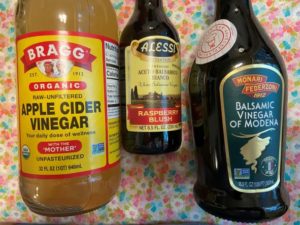Hot dogs and Quinoa: We need a little Citrus, right this very minute!
My husband thinks I make the best eggs. He told me when we first met that he doesn’t eat eggs. He hasn’t eaten eggs his whole life. When he was a kid and eggs were served, he would refuse to eat because they are gross. They are slimy and wet, and they have no flavor. He just doesn’t eat eggs. But now he asks for eggs. He eats them over medium and dips his toast in the yolk. He will eat them scrambled in a taco shell with peppers and onions. He will eat them chopped up and added to a potato salad.
“I am the egg man
They are the egg men
I am the walrus
Goo goo g’joob”
-The Beatles
Why the change? He says he doesn’t know what I do to them, but something about the way I cook them makes them taste amazing. (My eggs are cooked in coconut oil. They get sprinkled with smoked sea salt and fresh ground black pepper.)
This isn’t the first time I have heard that the things I cook taste better. It isn’t a trick, a pan, or a technique. I don’t use a special recipe for any of my cooking. Usually, I don’t use a recipe at all. This is both frustrating for my sister-in-law who occasionally asks for the recipes and exciting for my guys as every time we eat it is a smidge different. The secret is that I have built an entire cupboard devoted to all of my seasonings. It is a beautiful and exotic collection of potion ingredients that I can mix together to create flavors. And, over the years I have learned how to build flavor and incorporate these seasonings into my cooking.
Knowing about seasonings isn’t how I started, however. Imagine stepping into the grocery store aisle and looking at a huge wall of spices. This display is taller than you are and wider than your arms can reach. Staring back at you are ground spices, whole spices, organic spices. There are seasoning mixes and brining kits. There is an entire shelf with nothing but different kinds of salt. Another shelf is devoted to pepper. Down the aisle, about 15 feet is another section of cooking oils. Then another section with nothing but different bottles of every kind of vinegar. Beyond that are barbecue sauces, mustards, and salad dressings. I didn’t know where to begin. I just knew I was tired of living in the land of bland.
At that time, I had acquired the pretty “this is my first apartment” spinning spice rack. I know you have seen them at the home goods stores. It is a fancy plastic and metal spice rack that comes complete with preloaded jars full of colorful spices. I used to have one. My mother used to have one, but it didn’t spin. My grandmother had a flat wooden one that hung on her wall. I was pretty sure when I was about 8 that grandma had a glass jar of rocks right there in her kitchen. Little, eight-year-old Sarah was surprised to learn that those rocks were whole nutmeg and not her collection of pristine, perfectly round, slingshot rocks.
Did you know that never, not once, in all the time I saw her cook, did I ever see her open that “rock” jar? Why? Because she didn’t know what to do with them. And when I started, neither did I.
I had to experiment. And, I had to open all of those little jars and tasted what was in each one. Once I knew what the spices tasted like, I need figure out what seasonings went together. I began paying attention to what spices were used in specific dishes. I also looked up recipes for spice “mixes” to discover what ingredients went into them. This helped me figure out what flavors went into a taco seasoning, or a chili mix. Once I understood some of the basic seasonings that were used for different culinary styles, it made cooking a lot easier, and tastier. I was learning how to build flavors.
I also took a cooking class on the Mediterranean Diet to discover more about regional foods. It described a Mediterranean “style” of cooking where they were using only a little meat. It was used more as a seasoning than as the main component of the meal. We were encouraged to try cooking Italian recipes for our friends and family and to create new dishes that aligned with the Mediterranean concepts of cooking. And, I totally bought into their idea of using non-traditional components as “seasonings.” This class explained we could season foods with vegetables, (celery, peppers, or garlic) fruits (raisins, cherries, or a spoonful of jam), or even nuts. Try making up a batch of spiced walnuts they are divine to sprinkle on your salad. I use these three components all the time and they add a real boost to the textural contrast and flavor.
 After taking the class on the Mediterranean Diet I started learning about wine. I learned in the class that having a glass of wine with the meals is common in Italy. I was new to wine and that occasionally meant I’d come across one I didn’t enjoy. Some of the bottles I picked up were not “wine”ers. I hate being wasteful, so I learned how to turn a mediocre wine into delicious wine vinegar. And learning to make wine vinegar became a stepping-stone to all the things vinegar can do for flavor. I have acquired a few fruit-based bottles. I would recommend adding at least one to your seasonings kit. I have balsamic, apple cider vinegar, my homemade red wine, rice wine, and a fancy raspberry that is divine over portabella mushrooms. I use vinegar in marinades, for salad dressings, I’ll add some to chili, or splash one of them over grilled asparagus spears.
After taking the class on the Mediterranean Diet I started learning about wine. I learned in the class that having a glass of wine with the meals is common in Italy. I was new to wine and that occasionally meant I’d come across one I didn’t enjoy. Some of the bottles I picked up were not “wine”ers. I hate being wasteful, so I learned how to turn a mediocre wine into delicious wine vinegar. And learning to make wine vinegar became a stepping-stone to all the things vinegar can do for flavor. I have acquired a few fruit-based bottles. I would recommend adding at least one to your seasonings kit. I have balsamic, apple cider vinegar, my homemade red wine, rice wine, and a fancy raspberry that is divine over portabella mushrooms. I use vinegar in marinades, for salad dressings, I’ll add some to chili, or splash one of them over grilled asparagus spears.
I also started experimenting with other styles of cooking from the Mediterranean area. I looked up recipes on how to make Italian, Greek, and Moroccan foods. It was in learning about Moroccan foods that I stumbled across preserved lemon.
I should tell you how much I love citrus. I am a November baby. November is when citrus is in season here in the States. When I was growing up, every year I would bring in sliced oranges for my birthday to school. And my love isn’t just for oranges, it’s for limes, clementines, grapefruits, etc. All of ‘em find their way to my table. Now that I’m an adult, when citrus time rolls around for my birthday, I make preserved lemon (or citrus, really all of them can be preserved). It is simple. It’s lemon, salt, pepper, and time. Not the seasoning thyme, clock ticking: time like “let it sit for months” kind of time. But it is worth it. A little pop of citrusy, tangy, peppy lemon in a coleslaw, in a curry, in a pasta salad…it is delicious! And the vitamin C from those citrus fruits is great for skin health and our immune system. Check out some of the me&my health up podcasts with Anthony for other ways to improve skin health and boost your immunity!
If you are interested in a seasoning game-changers I highly recommend adding a velvety wine vinegar and tangy preserved lemon to your spice cabinet. Bonus, both the wine vinegar and the preserved lemons are fermented foods and beneficial to your gut health! Put up a batch of preserved lemon so you can stir some citrus into your curry or make a batch of homemade red wine vinegar to splash on some Cuban Style Black Beans.
Finally, I wanted to let you know that I have continued my new healthy habit of the gratitude journal for six weeks now! I find on days when I don’t keep up with it, I have a harder time getting to sleep. I used to think after a bad night’s sleep I could just have more caffeine and keep going. It was readily available since I work at a coffeehouse. As I have learned more on my health journey, I have come to realize how important good sleep habits are to my overall health. If you are curious check out Coffee-Habitual? Harmful? Helpful? For me, the routine of the nightly gratitude journal helps me to wind down and put an end my day.
Blog written by Sarah Holtz on 16th July 2021


